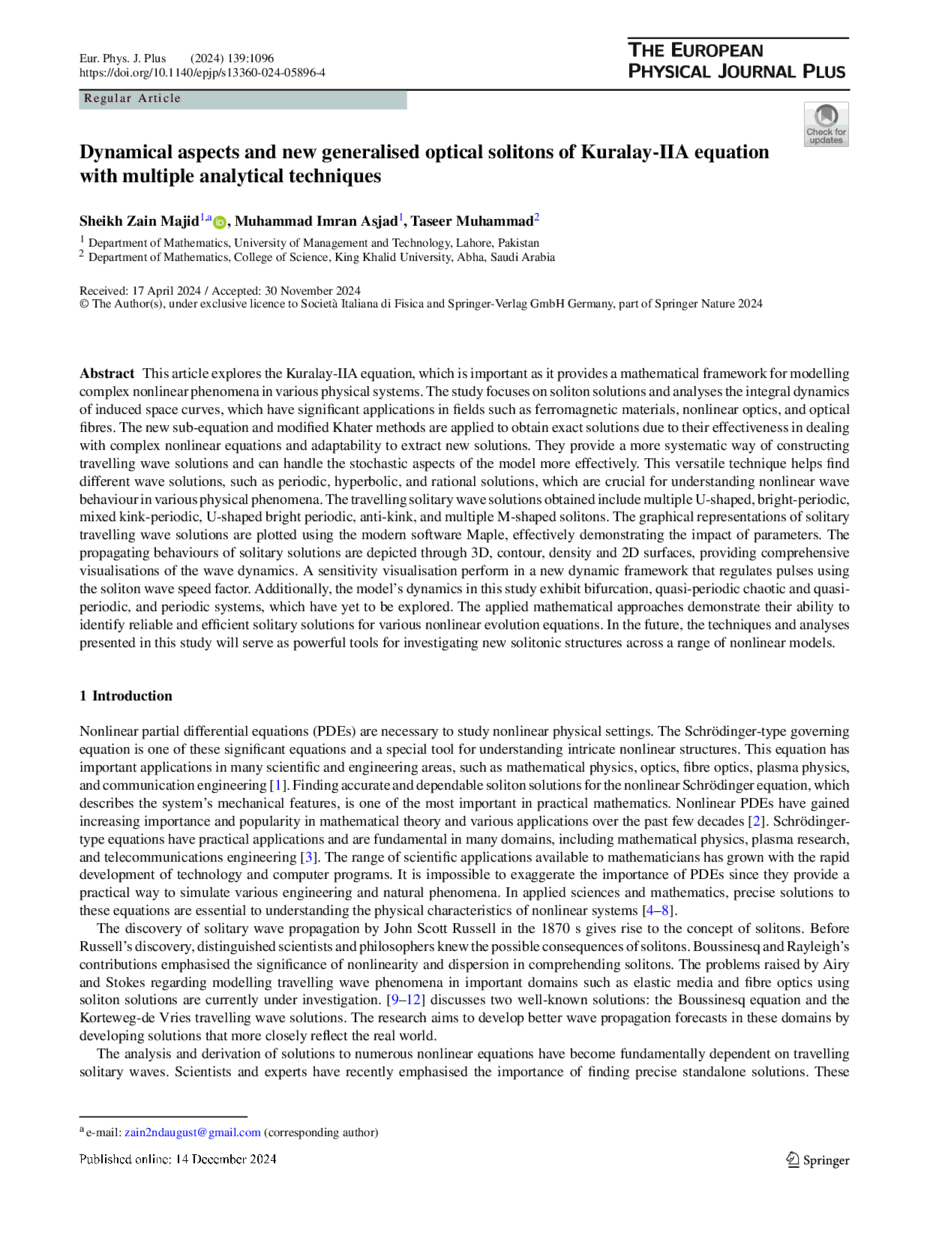https://doi.org/10.1140/epjp/s13360-024-05896-4
Regular Article
Dynamical aspects and new generalised optical solitons of Kuralay-IIA equation with multiple analytical techniques
1
Department of Mathematics, University of Management and Technology, Lahore, Pakistan
2
Department of Mathematics, College of Science, King Khalid University, Abha, Saudi Arabia
Received:
17
April
2024
Accepted:
30
November
2024
Published online:
14
December
2024
This article explores the Kuralay-IIA equation, which is important as it provides a mathematical framework for modelling complex nonlinear phenomena in various physical systems. The study focuses on soliton solutions and analyses the integral dynamics of induced space curves, which have significant applications in fields such as ferromagnetic materials, nonlinear optics, and optical fibres. The new sub-equation and modified Khater methods are applied to obtain exact solutions due to their effectiveness in dealing with complex nonlinear equations and adaptability to extract new solutions. They provide a more systematic way of constructing travelling wave solutions and can handle the stochastic aspects of the model more effectively. This versatile technique helps find different wave solutions, such as periodic, hyperbolic, and rational solutions, which are crucial for understanding nonlinear wave behaviour in various physical phenomena. The travelling solitary wave solutions obtained include multiple U-shaped, bright-periodic, mixed kink-periodic, U-shaped bright periodic, anti-kink, and multiple M-shaped solitons. The graphical representations of solitary travelling wave solutions are plotted using the modern software Maple, effectively demonstrating the impact of parameters. The propagating behaviours of solitary solutions are depicted through 3D, contour, density and 2D surfaces, providing comprehensive visualisations of the wave dynamics. A sensitivity visualisation perform in a new dynamic framework that regulates pulses using the soliton wave speed factor. Additionally, the model’s dynamics in this study exhibit bifurcation, quasi-periodic chaotic and quasi-periodic, and periodic systems, which have yet to be explored. The applied mathematical approaches demonstrate their ability to identify reliable and efficient solitary solutions for various nonlinear evolution equations. In the future, the techniques and analyses presented in this study will serve as powerful tools for investigating new solitonic structures across a range of nonlinear models.
Copyright comment Springer Nature or its licensor (e.g. a society or other partner) holds exclusive rights to this article under a publishing agreement with the author(s) or other rightsholder(s); author self-archiving of the accepted manuscript version of this article is solely governed by the terms of such publishing agreement and applicable law.
© The Author(s), under exclusive licence to Società Italiana di Fisica and Springer-Verlag GmbH Germany, part of Springer Nature 2024
Springer Nature or its licensor (e.g. a society or other partner) holds exclusive rights to this article under a publishing agreement with the author(s) or other rightsholder(s); author self-archiving of the accepted manuscript version of this article is solely governed by the terms of such publishing agreement and applicable law.





